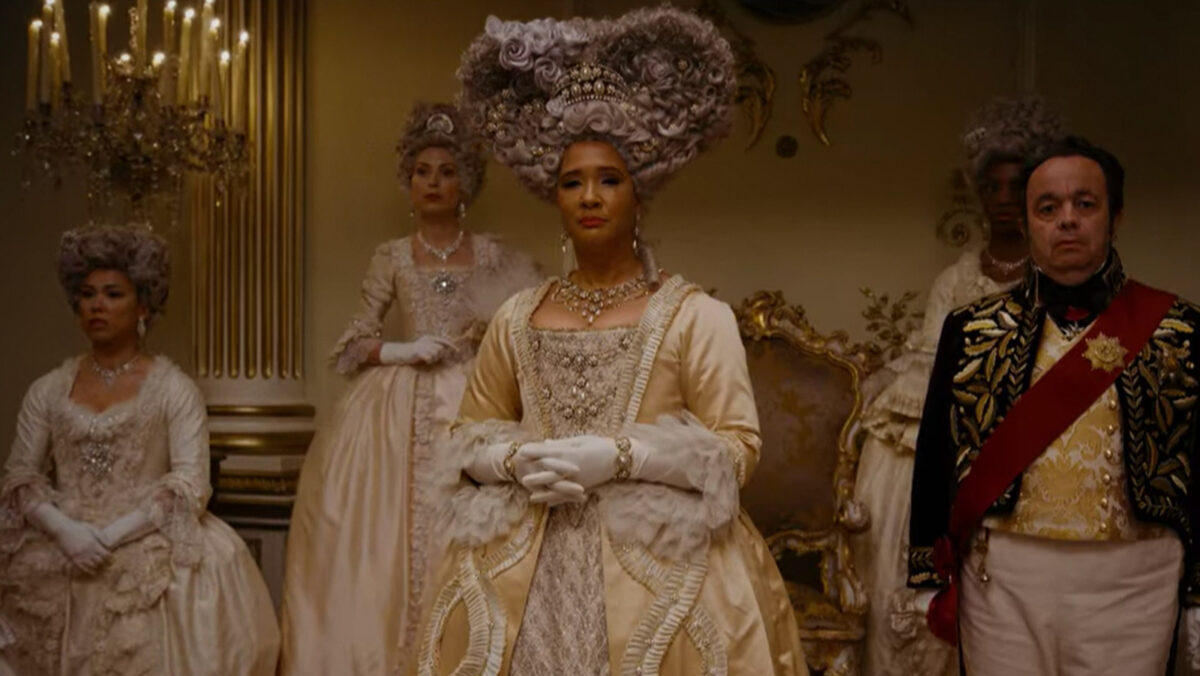Studios Rumored to Ban Corsets From Period Pieces—But Are the Corsets Actually the Problem?

I never thought I’d be defending corsets on a feminist website, but life takes you to funny places sometimes. Earlier this week, several news outlets reported that Netflix and the BBC were banning the use of corsets in costumes for period shows like Bridgerton. Why? Because they had received complaints from actors who had been injured from wearing corsets during long shoots.
For example, Simone Ashley, who plays Kate Sharma in Bridgerton, told Glamour that “I had a lot of pain with the corset … I think I tore my shoulder at one point.”
After the story broke, Jezebel reported that both Netflix and the BBC denied that they were banning corsets. Still, the news spread quickly because of corsets’ reputations as constrictive torture devices. We’ve all seen the horror of corsets onscreen: a well-to-do lady grips a bedpost while her maids pull at the laces with all their might, compressing her lungs to raisins. We’ve heard the legends of 19th century women getting ribs surgically removed to make their waists smaller. Of course real-life corsets would be injuring actors—that’s what corsets are designed to do!
Except the horror stories we’ve heard about historical corsets aren’t actually true. According to Smithsonian Magazine, women throughout European history had a range of options when it came to corsets and similar undergarments, and corsets were designed to be relatively comfortable. If women wanted their waists to look smaller, they would usually pad their hips to create the desired shape.
Dr. Amanda Vickery, a professor of early modern history at Queen Mary University of London, pointed out on Twitter that a properly-fitted corset shouldn’t hurt.
Other people on Twitter agreed with Vickery, sharing their experiences using properly-fitted corsets for everything from costume design to lumbar support while performing surgery.
This conversation was an aha moment for me. I’ve only ever worn the occasional corset for ren faire costumes, and I’ve never bothered make them super tight, but I realized corsets are like any other garment—if they’re giving you bruises and blisters, it means something is wrong.
As I read the unfolding conversation around corsets, I also found myself thinking about another source of socially acceptable pain: IUDs.
“Women’s pain” is normalized
If you follow reproductive health issues online, you tend to see a lot of stories about the insertion of intrauterine devices, a form of birth control in which a small contraceptive is inserted into your uterus. People who get UIDs often share stories of shockingly painful insertions—procedures that leave them crying or even passing out from pain—yet anesthetic for UID insertion is still largely unheard of. Other sources of severe reproductive pain associated mainly with women, like endometriosis or fibroids, are routinely brushed off and ignored.
Like UIDs, corsets tend to be filed away under “women’s issues,” which means that any pain they cause is normalized. It’s seen as a nonissue if actors’ corsets are pinching, hurting, and leading to injuries, because corsets are supposed to do that. If the rumors about Netflix and the BBC were true, then banning them would definitely be more enlightened than telling actors to get used to it, but it’s telling that so few people in the film and TV industry seem to be questioning their preconceived notions of how corsets work.
There’s another layer to all this, too. Multiple writers, including Vickery, are pointing out that corsets have become a convenient symbol for “the prison of femininity.” Vickery points out that embroidery is also associated with the oppression of women.
As an embroiderer, I have to wonder why making art with a needle and thread is seen as drudgery, while art forms historically associated with masculinity, like painting or woodworking, are seen as valuable skills. Maybe the corset conversation will open up some breathing room (get it?) in our conversations about how we view femininity.
(featured image: Netflix)
Have a tip we should know? [email protected]
